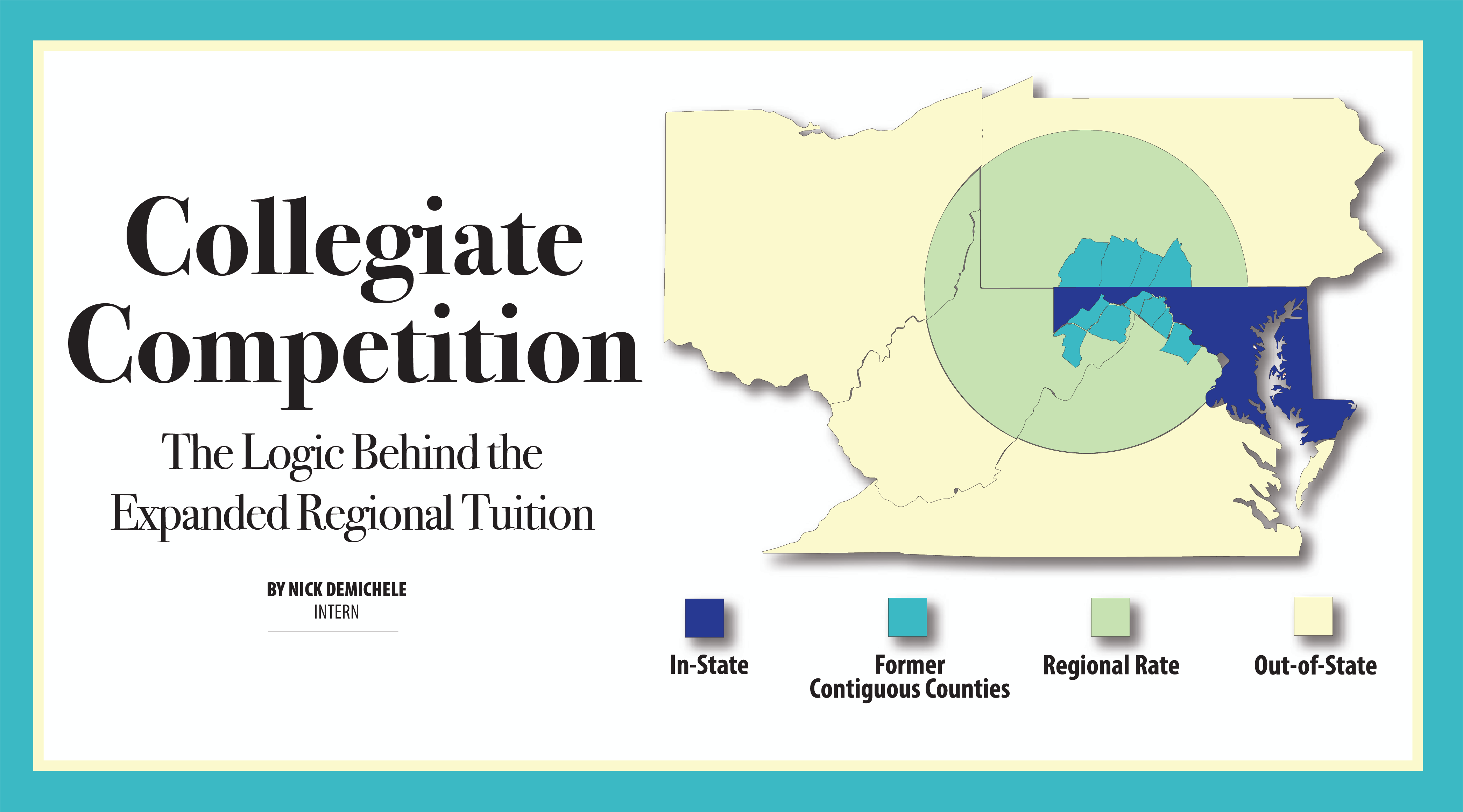Collegiate Competition: The Logic Behind the Expanded Regional Tuition
Frostburg State University recently announced a hefty expansion of its regional tuition rate. The increased area will allow students farther away from the university to be eligible for a tuition rate at a reduced price – less than out-of-state tuition but still more than in-state tuition. While the campus is in the midst of a budget crisis, this may appear to be a counterproductive to combating fiscal cuts. However, a closer look reveals the strategic importance of the expansion.
Frostburg State University has a reputation of giving students “bang for their buck.” In fact, FSU’s online MBA program was named one of the Affordable College Foundation’s top programs, based upon its affordability. When compared to other University System of Maryland institutions, FSU has long been thought of as an affordable choice for an undergraduate career. And while FSU technically falls in the dead center of the USM ranking for annual tuition and fees, the City of Frostburg has a substantially lower cost of living than the cities which house other USM institutions. In fact, the FSU is located in the cheapest place to live out of all USM institutions. With a Cost of Living Index rating of 87.6 (100 is the national average), Frostburg is considerably more affordable than all other USM institutions, especially College Park, who boasts a whopping Cost of Living Index rating of 133.5 – higher than the national average.
The idea of “regional rates” which fall in-between the in-state and out-of-state rate originated as “contiguous county” rate, which gave residents in the counties of Mineral, Hampshire, Berkeley, Grant, Jefferson, and Morgan in West Virginia and Somerset, Bedford, Fulton, and Franklin in Pennsylvania, as well as Virginia’s Loudoun County, the opportunity to attend FSU – a local institution – at a reduced rate. FSU’s position in the Maryland panhandle makes it unique in the USM system: it’s proximity to West Virginia and Pennsylvania makes it the only institution in the system to provide a “regional” (formerly “contiguous county”) rate.
The expansion of the regional rate extends the rate to students living within a radius of 120 miles from FSU. That radius includes multiple counties in Pennsylvania, Virginia, West Virginia, and even Ohio. The regional rate of $15,212 for annual tuition and mandatory fees saves students in this radius around $4,500 when compared to the out-of-state rate of $19,616. This annual rate includes the approved tuition increase in response to recent budget cuts.
Taking effect in the fall semester of 2015, the policy change is expected to help FSU become competitive with schools in Pennsylvania, West Virginia, Virginia, and Ohio. In some instances, it may actually be cheaper for students to come to FSU than an institution within their own state.
Consider the University of Pittsburgh. Students in the Pittsburgh area are expected to pay an average (Pitt has different tuition rates for their different inter-institutional schools) yearly $20,238 in tuition and fees to Pitt – for in-state tuition. Students living in Pennsylvania could get a more affordable undergraduate education at FSU – with about $5,026 in pocket change. Pittsburgh also has a Cost of Living Index rating of 95.2.
While FSU competes with in-state schools for their own students, it dominates the field concerning out-of-state tuition. Take West Virginia University, for example. While the Cost of Living Index of Morgantown is a competitive 90.6, and while the annual in-state tuition of WVU remains a low $6,960, it’s out-of-state annual tuition skyrockets to $20,424. A student living in the Tri-State region of Pennsylvania would be better served by going to Frostburg, who offers a regional tuition rate about $5,212 lower than that of WVU. These numbers include mandatory fees.
Outgoing President Dr. Jonathan Gibralter detailed the geographic boundaries of the expansion as “reaching north past Pittsburgh and State College, west as far as Wheeling, south to Charlottesville and east to encompass most of Alexandria and Harrisburg.”
Dr. Joseph Hoffman, Dean of the College of Liberal Arts and Sciences, sees the potential impact this expansion could have on enrollment and recruitment at FSU. With more individuals being eligible for a decreased tuition rate, FSU could see a noticeable boost in enrolled students. With more students likely coming to FSU from neighboring states, a trickle down effect could occur: out-of-states students would be more likely to require on-campus housing, as they would be unable to commute as many students native to the area do. Dr. Hoffman states that the expansion was “larger than [he] expected” and that he anticipates the change to “be a good thing.”
As previously reported by The Bottom Line, FSU hopes to admit a record class of 1,000 first-time freshmen in the fall of 2015. When TBL spoke in February with Associate Vice-President for Admissions and Financial Aid Wray Blair, Mr. Blair reported that Admissions is “currently ahead of last year on offers of admission and paid admission deposits for freshman applicants.” Blair stated that he believes enrolling 1,000 first-time freshmen is “an attainable goal.” The expanded regional tuition rate may, indeed, help the university reach this benchmark.
As the USM continues to grapple with its bleeding-out budget, FSU hopes to attract more students (and money) through innovate new initiatives like this tuition policy expansion. Who knows? Depending on the success of the policy, FSU may lead the USM pack in attracting other students from the Mid-Atlantic region.





1 Comment